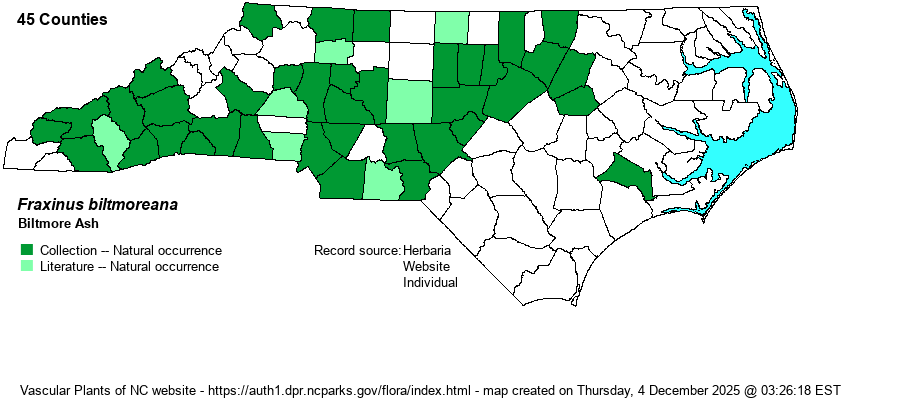| Author | Beadle | |
| Distribution | Scattered over the Mountains and Piedmont, east to the Fall Line. A specimen record exists for Jones County, if correct, but absent in the rest of the Coastal Plain.
The range is smaller than for White Ash (F. americana), being from NJ, OH, and IL south to central GA and LA. Exact details of the range are not clear, as this taxon is often overlooked by biologists, owing to it only recently being split out (since about 2018) from F. americana by most authorities.
| |
| Abundance | Not well known, though it is apparently fairly common in the Piedmont and the southern Mountains. Certainly, it is much less numerous than is White Ash. Absent in the Coastal Plain, except for Jones County. Specimens are known from many counties across the Mountains and Piedmont. The NCNHP gives a state rank of S2S4 (as opposed to S5 for White Ash), The website editors suggest a rank of S4 is better than S2S4. The NCNHP has placed this species on its Watch List as W2 (Questionable Taxonomy), though this seems an unnecessary move to the website editors, and do not feel it should be on a Watch List. | |
| Habitat | The habitats are not well distinguished from those of White Ash, but are believed to be very similar, though this species seems more restricted to circumneutral soil. It is most numerous in rich or mesic forests over circumneutral soil. Interestingly, RAB (1968) says “Low woods”, but this is incorrect; it is not a wetland species. The Moore County record is from a dry oak-hickory forest; the Richmond County record (June 2021) is from dry rocky woodland on a mafic slope. |
| Phenology | Apparently the same as for White Ash – flowering in April and May, and fruiting from August to October. | |
| Identification | Biltmore Ash is a tree that is very similar to White Ash, but as both species grow in close association in upland forests, it cannot simply be considered as a variety now. However, up close, in the hand, you can easily separate these two. Biltmore Ash has very strong pubescence on the leaf petiole and rachis, as well as the twigs. At a distance of maybe 5 feet or more, these may not be obvious, but a hand lens is not needed once you have a leaf or twig in your hands. (White Ash is glabrous/smooth on the rachis, petiole, and twigs.) There are a few other separations, such as the petiole bases and leaf scars – check references such as Weakley (2018), and size of the fruit (samaras). Biltmore Ash has larger samaras than does White Ash. | |
| Taxonomic Comments | Most references now list this taxon as a full species, but a few likely consider it as a variety of White Ash – F. americana var. biltmoreana. Weakley (2024) has considered it as a good species since 2018.
| |
| Other Common Name(s) | Biltmore White Ash | |
| State Rank | S2S4 [S4] | |
| Global Rank | G5 | |
| State Status | W2 | |
| US Status | | |
| USACE-agcp | | |
| USACE-emp | | |

